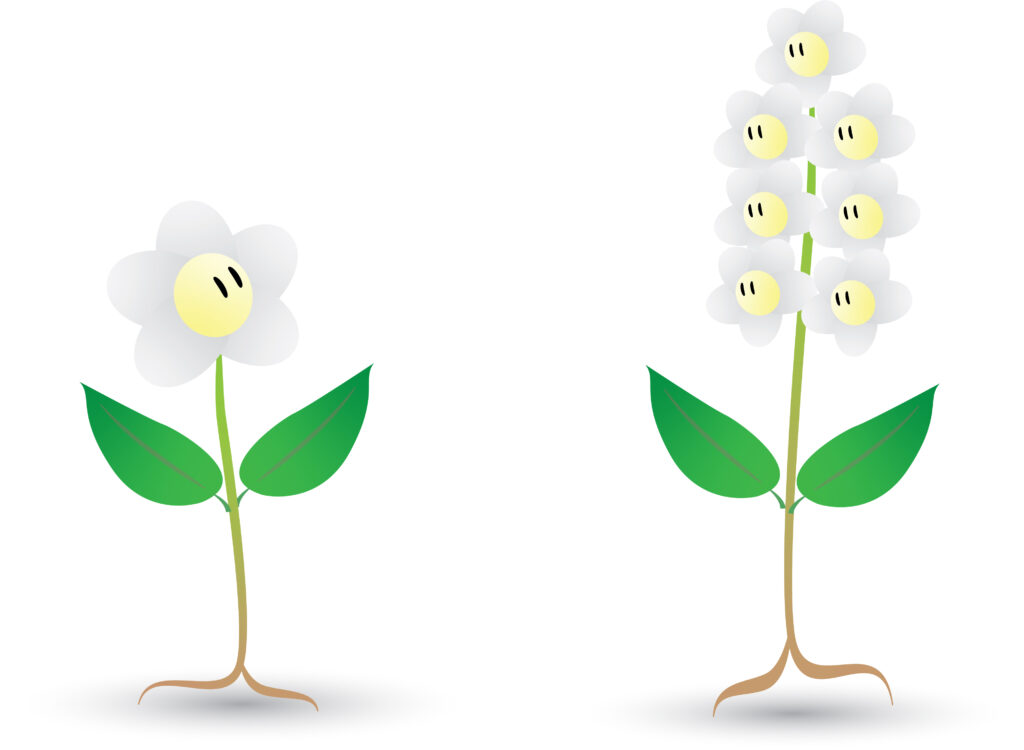A flower is the reproductive organ of flowering plants. After successful pollination via self- or cross-pollination aided by pollinators, the flower turns into fruits or seed pods. However, the “flowers” are not always called flowers, sometimes they are referred to as inflorescence. What are the differences and relationships between a flower and an inflorescence?
A flower, known as bloom or blossom is the seed-bearing part of a plant that consists of reproductive organs like stamens and carpels that botanically known as an incomplete flower. Morphologically the flower is the modified shoot that serves as the reproductive organ, surrounded by a brightly colored corolla and a green calyx known as petals and sepals. However, an inflorescence is defined as a complete flower head of a plant that includes stems, stalks, bracts, and flowers. More specifically, it is a cluster of flowers arranged on a floral axis.
If we take a closer look at the flowers, the pedicel is the stalk of the flower. In comparison, the peduncle is the stalk of the inflorescence. A flower has distinct nodes and internodes, which are not observed in that of the inflorescence. Flowers produce gametes, which then undergo fertilization, that eventually form seeds protected by seed pods or flesh in term of fruit—inflorescence of flowering plant functions to increase cross-pollination chances, for example, a sunflower head can contain as many as 1000 to 2000 seeds. Examples of the flower are rose and Rafflesia sp. The examples of inflorescence are Nepenthes sp. and Titan arum. That is why Rafflesia sp. is the largest flower in the world, while Titan arum (corpse flower) is the largest unbranched inflorescence in the world.
Flowers or inflorescence are one of the keys to help botanists taxonomically identify and classify the plants. Also, each flowering plant has its floral formula, which is the set of numbers, letters, and symbols that are used to represent the structure of a flower. The floral formula is used to present factual information about the flower in a compact form and is widely used in some herbariums to help characterize higher taxa. The floral formula is developed during the nineteenth century to describe flower structure apart from using floral diagrams in plant taxonomy and systematics. A floral formula contains the key data about the floral structure by expressing the organ numbers (number of stamen and carpels), fusion, symmetry, or arrangement of the whole flower (spiral arrangement, asymmetry, monosymmetry, dissymmetry, and polysymmetry), as well as sexuality.
Flowers are beautiful organs that often being used to decorate during festive seasons and used for landscaping due to their aesthetic appearances and meaningful implications. For instance, carnations represent the flower for Mother’s Day, and poinsettias are planted and sold during Christmas. Many flowers like orchids are being grown as houseplants or indoor plants, which add some delicacy and exquisiteness to the house and produce mild fragrance throughout the flowering period. Flowers are also used as a gift in a bouquet in fresh or dried form, and it is believed that various numbers and colors of flowers have different floral meanings. For example, red roses symbolize love and romance, which are the perfect Valentine’s gifts. Orange roses symbolize enthusiasm and passion, whereas yellow roses symbolize friendship. Flowers are also used in culinary as decoration or edible ingredients and flower tea. Besides, certain flowers are chosen as national flowers for most of the countries.

Further reading: